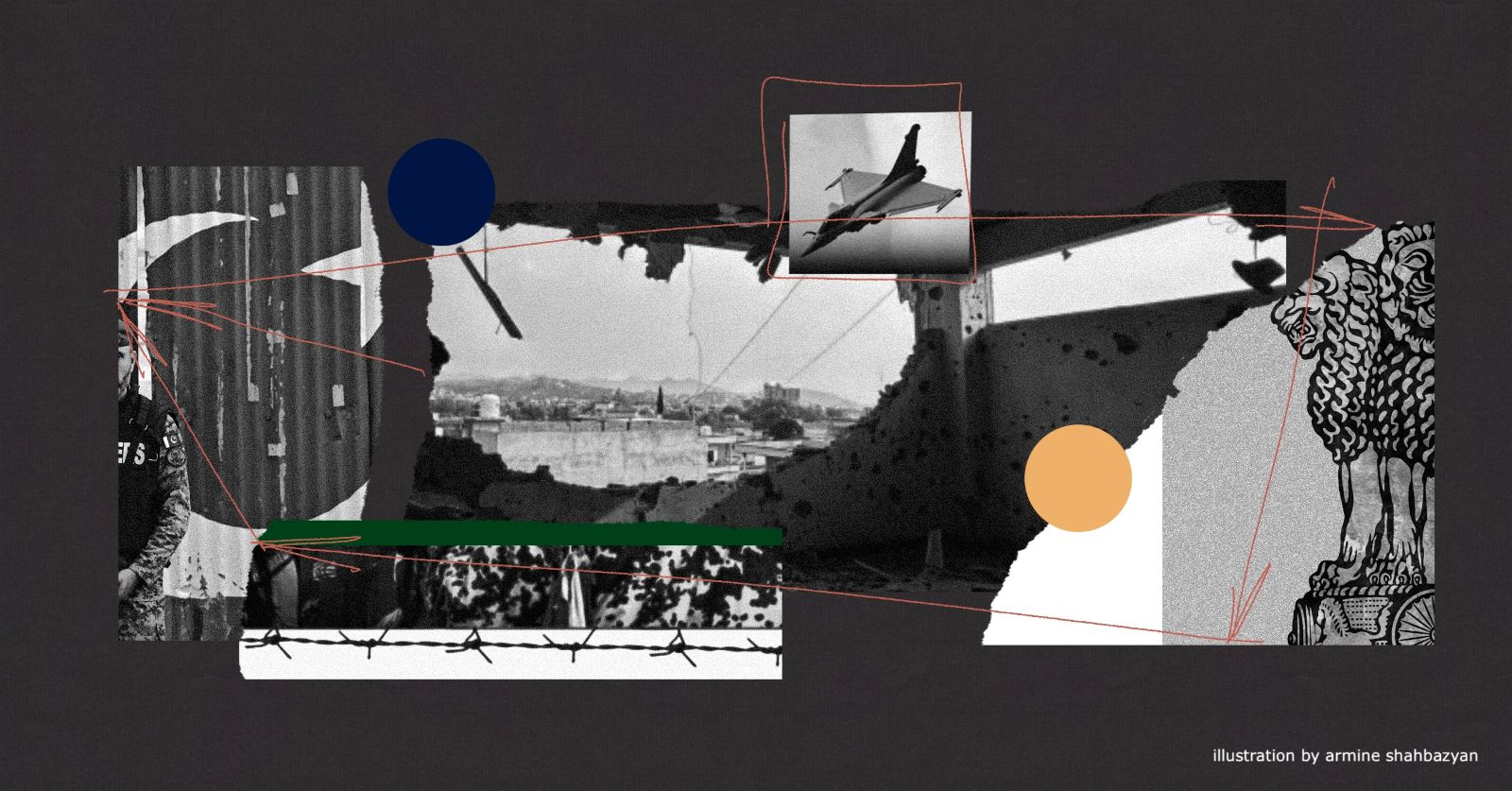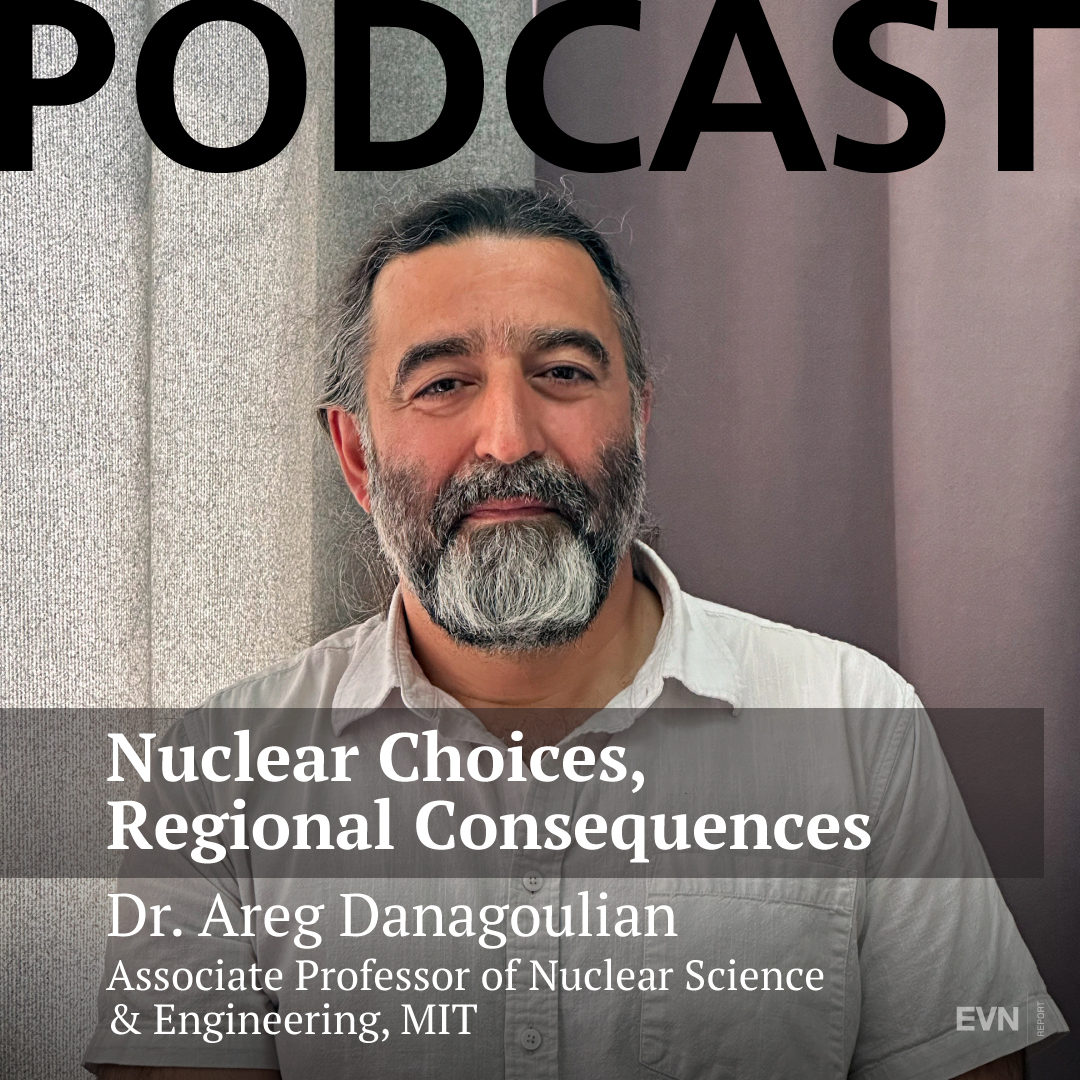
Listen to the article.
While the war in Ukraine drags on, and Israel’s ongoing military campaign in Gaza show no signs of ending—the latter even extending to Iran—the recent India-Pakistan conflict lasted less than a week, underscoring the critical role of nuclear deterrence. This escalation demonstrated both the effectiveness of nuclear deterrence and exposed the grave challenges of nuclear decision-making. The conflict further consolidated the nexus between the “Three Brothers” alliance of Turkey, Azerbaijan and Pakistan, prompting Armenia to consider potential trilateral and quadrilateral formats to balance this growing axis. Finally, the conflict highlighted the effectiveness of Indian weapons—some of which have already entered Armenia’s arsenal—while also showcasing the capabilities of systems used by the opposing camp.
This article first briefly outlines the evolution of nuclear deterrence theory, providing context for understanding India and Pakistan’s nuclear doctrines and their historical implementation. It then examines how nuclear deterrence functioned during the recent conflict, how this confrontation differed from previous escalations, and what broader lessons can be drawn, particularly in light of certain trends in the Russian-Ukrainian war. The second section addresses the regional dimension, analyzing the deepening cooperation among Turkey, Azerbaijan and Pakistan within the “Three Brothers” alliance. The article then explores regional formats Armenia could engage with to counterbalance this emerging axis by examining specific options. Finally, it evaluates the performance of weapons systems used by both sides, focusing on Indian systems that Armenia has already acquired and other systems it may face in potential future conflicts.
Introduction
India and Pakistan, the two nuclear-armed powers of South Asia, engaged in a military escalation unprecedented in scale over the past half-century. The four-day conflict involved intense fighting, including artillery duels, drone warfare, and dogfights.
The conflict was triggered by the killing of 26 civilians in Indian-administered Kashmir on April 22, which India blamed on Pakistan. On May 7, under Operation Sindoor, India launched missile strikes deep into Pakistani territory—targeting sites in Punjab and Pakistani-administered Kashmir—and claimed to have hit nine “terrorist infrastructure” locations. This was followed by a dogfight involving approximately 125 fighter jets. Pakistan reported shooting down five Indian jets, including three Rafales, a MiG-29, and a Su-30.
In response, Pakistan launched a series of drone and missile strikes on May 7 and 8. India retaliated with its own drone attacks, targeting key Pakistani military assets, including a Chinese-made HQ-9 missile defense system. Cross-border shelling intensified and on May 9, both sides were engaged in sustained drone warfare and artillery duels. India also repositioned its Western Fleet, deploying an aircraft carrier. A U.S.-brokered ceasefire was reached on May 10, bringing the four-day confrontation to a halt.
The Evolution of Nuclear Deterrence Theory
The advent of the atomic bomb by the U.S. under the Manhattan Project in July 1945 marked the beginning of the nuclear age and the Cold War arms race. The U.S. atomic monopoly was short-lived, undone by a Soviet espionage operation orchestrated by Lavrenti Beria, head of the USSR’s NKVD.
The threat of a looming Armageddon not only accelerated weapons development but also spurred new strategic thinking. The term “conventional” came to describe warfare below the nuclear threshold. In “Arms and Influence”, Thomas Schelling popularized concepts such as coercion, compellence, deterrence and preemptive strikes. Coercion uses threats to influence an adversary’s behavior; deterrence threatens punishment to prevent action; compellence pressures an adversary to act under threat of harm; preemptive strikes involve attacking first in anticipation of an imminent, confirmed assault.
The condition of mutual assured destruction (MAD) was central to nuclear confrontation, wherein neither the U.S. nor the USSR could defend its population, as both retained second-strike capability—even after a counterforce attack targeting nuclear arsenals. In this environment of mutual vulnerability, each side could retaliate with catastrophic force, including strikes on countervalue targets such as cities—a posture termed mutually assured retaliation. Some scholars argued that credible deterrence relied more on absolute capability than on relative force size. As long as both sides maintained second-strike capability, neither superiority nor first strikes could eliminate the threat of retaliation. This dynamic created crisis stability, where the fear of initiating a self-destructive war served as a stabilizing force.
However, the growing sophistication of counterforce—driven by advances in precision strikes, delivery systems, command and control, and surveillance—began to erode the credibility of assured retaliation. States increasingly considered disarming adversaries through a first strike. Earlier doctrines focused on maintaining second-strike capability—such as the flexible response approach associated with the punitive retaliation school. However, a shift occurred toward doctrines emphasizing first-strike capability. The U.S., for example, adopted a “countervailing strategy” grounded in the military denial school, which remains relevant today despite concerns that first-use counterforce increases the risk of preemptive action. This evolution led to both the expansion of nuclear arsenals and sustained efforts to maintain escalation dominance at every level of conflict.
Nuclear Deterrence in Action: Regional Crisis and Broader Implications
India and Pakistan—acquiring nuclear weapons in 1974 and 1998, respectively—are among the world’s nuclear-armed states, along with the U.S., Russia, China, France, the United Kingdom, North Korea, and Israel. Both are considered minor nuclear powers, each possessing a similar number of warheads: approximately 172 for India and 170 for Pakistan. They have improved their command and control systems, diversified delivery platforms, and continue to enhance the quality and survivability of their arsenals. However, their nuclear doctrines differ significantly. India’s doctrine is based on mutual assured retaliation, underpinned by a No First Use policy and a credible minimum deterrence. Pakistan maintains a more ambiguous strategy, reserving the option of first use, including tactical nuclear weapons (TNWs) against conventional attacks.
This aligns with the theory of conventional inferiority, which holds that weaker conventional forces may rely on nuclear weapons to offset the imbalance. Facing conventional inferiority vis-à-vis India, Pakistan uses its nuclear arsenal to bridge the gap. In contrast, India—possessing sufficient conventional capabilities to deter both Pakistan and China—maintains its arsenal primarily for strategic deterrence.
Pakistan has long leveraged its nuclear arsenal through salami-slicing tactics, signaling that any large-scale Indian conventional response to its limited attacks could trigger nuclear escalation. This has added a new dimension to the stability-instability paradox. A core feature of nuclear deterrence is that strategic instability can create tactical stability: the fear of nuclear confrontation restrains conventional conflict. However, in the India-Pakistan context, strategic instability has instead fueled tactical instability. Pakistan uses the threat of nuclear escalation to enable limited conventional attacks, while India remains deterred from launching a full-scale conventional response.
As in past escalations, Pakistan’s nuclear deterrence held, reaffirming the perceived benefits of nuclear weapons. What set this confrontation apart was India’s deep conventional strikes into Pakistan’s heartland—well beyond the Line of Control. These strikes not only sharply raised the risk of nuclear conflict but also signaled India’s growing refusal to tolerate nuclear blackmail. Prime Minister Modi declared that India would “retaliate on its own terms” and would not “tolerate nuclear blackmailing” by Pakistan. This rhetoric reflects a shift in India’s posture and a greater willingness to impose costs on future provocations.
Notably, the limited nature of India’s response—confined to missile strikes and drone warfare—suggests that Pakistan’s nuclear deterrent remained effective. Once again, conventional inferiority was offset by nuclear capability. This reaffirms that nuclear weapons remain among the most effective deterrents, especially for states facing conventionally superior adversaries. In the context of shifting geopolitical dynamics—including growing doubts about the credibility of U.S. extended nuclear deterrence—this may encourage latent nuclear powers such as Japan and certain European states, including Germany, to reconsider acquiring their own arsenals.
The confrontation once again underscored the complexity of nuclear decision-making, raising critical questions of where the threshold lies—what line, when crossed, would prompt a nuclear power to use its arsenal. This ambiguity highlights a central challenge in nuclear deterrence: the credibility of threats. These dilemmas are reflected in the ongoing war in Ukraine and carry serious implications for the stability of the global deterrence regime.
The Kremlin has consistently leveraged its nuclear arsenal to pursue an aggressive foreign policy—from redrawing post-Soviet borders to deterring Western support for Ukraine. Russia’s nuclear signaling aimed to block the transfer of advanced weapons systems, including ATACMS missiles, F-16 fighter jets, Leopard 2, Challenger 2, and M1 Abrams tanks, as well as Patriot air defense systems. Yet over time, the West has delivered—or is delivering—all of these weapons, steadily raising the threshold for nuclear use. Ukraine’s recent Operation Spider Web, targeting Russian strategic bombers deep inside Russian territory, further tested Moscow’s red lines. The West’s incremental escalation in arming Ukraine, Kyiv’s deepening attacks into Russian territory, and even India’s strikes against Pakistan all illustrate the extraordinary difficulty of crossing the nuclear threshold. Despite aggressive rhetoric, the actual decision to use nuclear weapons remains constrained by immense strategic, political, and psychological barriers.
The Conflict’s South Caucasus Dimension and Why It Matters for Armenia
Notably, the escalation carries not only important implications for nuclear deterrence but also strategic relevance for the South Caucasus and Armenia.
The conflict further consolidated the nexus between the so-called “Three Brothers” alliance of Turkey, Azerbaijan, and Pakistan. Some Indian media described the conflict as a “100-hour war” not just against Pakistan, but against the broader “Three Brothers” network: Pakistan as the face, Turkey as the weapons provider, and Azerbaijan as the source of a coordinated disinformation campaign. Both Turkey and Azerbaijan were among the first to condemn Indian counterterrorism strikes. Hours after the attack in Pahalgam, during a press conference in Ankara, Pakistan’s Prime Minister Shehbaz Sharif thanked President Erdogan for his “unwavering” support on Kashmir. Soon after, reports surfaced alleging Turkish military assistance to Pakistan—claims Ankara denied, explaining that a Turkish cargo plane had landed in Pakistan only for refueling. This was followed by the arrival of the Turkish naval warship TCG Büyükada (F-512) at Pakistan’s Karachi port. Erdogan reiterated his solidarity shortly after India’s “Operation Sindoor,” referring to the events as the “martyrdom of numerous civilians.” Notably, the 300–400 drones deployed by Pakistan during the conflict were of Turkish origin.
Along with providing diplomatic support, Azerbaijan—unlike Turkey’s more visible military assistance—engaged actively in disinformation warfare. Baku condemned the Indian airstrikes and expressed solidarity with Pakistan. State-affiliated media outlets, such as Caliber, disseminated false information about the Kashmir conflict, accused India of “water terrorism,” labeled its government as a “fascist-leaning regime,” and amplified Pakistan’s narrative. Azerbaijani sources sought to portray India’s deterrence posture as ineffective by characterizing its weapon systems as underperforming.
The trilateral summit held in Lachin on May 28 further cemented the strategic partnership among the three countries. It signaled a shared determination to expand their regional influence—from Western to South and Central Asia—and elevate their partnership to a broader geopolitical level. Coordination across diplomatic, military, and informational fronts suggests that the parties have developed procedures for collective action and are gaining practical experience. This is illustrated by the substantial support Pakistan and Turkey provided to Azerbaijan during the 44-day war, where each country contributed according to its comparative strengths. This external balancing effort reflects a pragmatic response to a shifting geopolitical order, as the three states seek to enhance their collective security by pooling and aggregating their respective resources.
The growing alliance between Turkey, Azerbaijan and Pakistan presents an increasing challenge for Armenia, necessitating renewed balancing efforts. During the Lachin Summit, Turkish President Erdogan emphasized that the three countries together have a population of approximately 350 million and a combined economic output of $1.5 trillion—underscoring the scale and potential of the partnership. This regional development, along with broader shifts in the international system, suggests that Armenia must not only deepen its ties with Washington and Brussels but also explore new alliances in trilateral and quadrilateral formats.
In a recent piece, Professor Nerses Kopalyan outlined the potential of a quadrilateral alliance between Armenia, France, India and Poland within the framework of secularized multilateralism. Taking into account the already robust bilateral cooperation among these countries—as well as their respective interests in the South Caucasus—he argues that Armenia’s main objective should be “situating the matrix of bilateral relations into a minilateral configuration, with the congruent and mutual interests of all four actors aligning.”
The emerging India–Armenia–Greece–Cyprus front could serve as a counterbalance to the Pakistan–Azerbaijan–Turkey alliance. Armenia, Greece and Cyprus, beyond their historical and cultural ties, have been deepening cooperation in the defense sector. In December of last year, the three countries signed defense cooperation plans for 2025, following a visit by Greek Defense Minister Nikolaos Dendias to Armenia on March 4. Armenia’s strategic partnership with India in the defense sector has grown steadily since 2022, with Armenia emerging as India’s largest customer for finished weapon systems, with purchases totaling $2 billion. India’s relations with Greece and Cyprus have also evolved, with New Delhi receiving an invitation to join the Eastern Mediterranean’s “3+1” format—originally composed of Greece, Cyprus, and Israel, with the U.S. participating informally—intended to counterbalance Turkey’s posture in the Eastern Mediterranean. Additionally, India signed military cooperation agreements with Cyprus and Greece in December 2022 and April 2023, respectively. Notably, this “quad” could potentially expand to include France, which maintains positive and growing relations with all four countries.
The Battlefield As a Testing Ground for Weapons Systems
Given that Armenia is one of the top purchasers of Indian armaments—and considering Turkey and Pakistan’s close military ties with Azerbaijan—it is important to examine how the weapon systems used by both sides performed during the recent conflict. Since 2022, Armenia has procured a range of military equipment from India. The table below outlines key equipment Armenia has purchased or agreed to purchase from India in recent years, some of which were deployed by India during the escalation.

The list is primarily based on “The Evolving India–Armenia Defense Partnership: Analyzing India’s Strategic Shift as a Security
Partner in the Caucasus” published by The Geopolitics, with additional details and updates incorporated by the author.
The latest 100–hour escalation demonstrated the effectiveness of Indian missile defense systems in countering drones and loitering munitions. Pakistan reportedly launched 300–400 Turkish-made drones—including the Asisguard SONGAR, Turkish-origin YIHA-III, and the renowned Bayraktar TB2 UCAVs—as well as over a dozen missiles against India. Most of these were either shot down or electronically disabled by India’s Integrated Counter-Unmanned Aerial System, or C-UAS.
Notably, the Akash surface-to-air missile systems—two variants of which, the Akash-1S SAM and Akash-NG SAM, have been procured by Armenia—played a central role in intercepting Turkish-made drones. Though some UAVs reportedly managed to penetrate Indian airspace and cause damage, India’s Ministry of Information and Broadcasting reported that a combination of shoulder-fired MANPADS, low-level air defense (LLAD) guns, and long-range SAMs effectively blunted successive waves of drones and loitering munitions. This suggests that Turkish-made drones—including the Bayraktar TB2, which proved highly effective for Azerbaijan during the Nagorno-Karabakh war—can be largely neutralized by India’s UAS architecture. Armenia, now integrating key components of this system into its arsenal, stands to benefit significantly from this proven defense capability.
Israeli drones used by India proved efficient, though not invulnerable. India reportedly deployed several Israeli-origin drones, including the IAI Searcher and Heron for intelligence, surveillance, and reconnaissance (ISR), as well as the Harpy and Harop for precision strikes, alongside its indigenous one-way attack (OWA) SkyStriker drones. Reports indicate that Harop drones—also deployed by Azerbaijan during the Nagorno-Karabakh war—were used to neutralize Pakistani air defense systems in Lahore. However, Pakistani sources claimed to have shot down 25 Harops. While the majority of Israeli drones appear to have accomplished their missions, Pakistani countermeasures demonstrated effectiveness in certain cases.
The recent escalation was particularly notable for the deployment of air forces by both sides. Pakistan deployed JF-17 Thunder Block III fighter jets—jointly developed with China—and fired PL-15 air-to-air missiles supplied by Beijing. The JF-17, with its upgraded combat capabilities, is reported to outperform Russian-made platforms, such as MiG-29, Su-25. Earlier this month, Azerbaijan signed a $4.6 billion agreement with Pakistan to purchase 40 JF-17 Thunder fighter jets. Indian media reported shooting down at least one JF-17, while losses reportedly included three Rafales and two Russian-designed fighter jets: one MiG-29 and one Su-30.
Conclusion
The 100-hour war demonstrated the enduring power of nuclear deterrence, increasing its appeal for countries facing stronger conventional adversaries. However, it also raised critical questions about nuclear thresholds and threat credibility: both Pakistan and Russia have refrained from using nuclear arsenals, even as presumed red lines were crossed. Notably, India announced at the highest level that it will no longer tolerate nuclear blackmail, significantly raising the stakes for any future confrontation.
The conflict also highlighted the growing cooperation within the “Three Brothers” alliance—Turkey, Azerbaijan, and Pakistan. In response, Armenia should consider engaging in alternative multilateral platforms such as Armenia–France–India–Poland and India–Armenia–Greece–Cyprus to counterbalance this emerging axis.
Podcast
Nuclear Choices, Regional Consequences
MIT nuclear physicist Dr. Areg Danagoulian analyzes Iran’s nuclear weapons program following recent Israeli strikes, assessing regional security implications for Armenia. The conversation explores Armenia’s nuclear energy future, the need for small reactors to replace aging infrastructure, and challenges in developing nuclear engineering expertise domestically.
Also see
Armenia Pursues Peace, Azerbaijan Seeks Coercion
Azerbaijan’s delay in committing to a peace agreement suggests a strategy of coercion to extract unilateral concessions and weaken Armenia’s sovereignty. The international community must go beyond praise and apply real pressure to ensure a fair, enforceable peace to stop the cycle of aggression.
Read moreRaising the Cost of War: Armenia’s Deterrence Strategies
Analyzing the complexities of Armenia's security and strategic challenges with Azerbaijan, Davit Petrosyan examines the country’s balancing strategies, military dynamics, and geopolitical risks, offering actionable policy insights to safeguard national interests and deter escalation.
Read moreHow Armenia Diversified Its Security Landscape in 2024
In 2024, Armenia made significant strides to diversify its security alliances, carefully distancing itself from Russia by freezing CSTO participation, joining the ICC, and reducing Russian border presence, while deepening ties with other partners. Hovhannes Nazaretyan wraps up the year.
Read morePolitics
Deterrence and Coercion: Armenia and Azerbaijan’s Diverging Defense Postures
As Armenia focuses on defense reforms aimed at deterrence, Azerbaijan intensifies its military build-up and superiority despite ongoing peace talks. Sossi Tatikyan analyzes diverging strategies, spending and alliances, highlighting how the military imbalance threatens regional stability and undermines prospects for lasting peace.
Read moreNew Frontiers: Armenia Looks to Central Asia
As Armenia reorients its foreign policy away from Russia, it is deepening ties not only with the West, but also with non-Western partners. Hovhannes Nazaretyan explores Armenia’s evolving engagement with Central Asian states as part of that strategy.
Read moreFairy Tales, Textbooks and Territorial Claims: Weaving the Myth of “Western Azerbaijan”
Azerbaijan has institutionalized the notion that Armenia is “Western Azerbaijan” through state-sanctioned textbooks, children’s literature, and academic curricula. Intensified since the 2020 war, this narrative reflects expansionist ambitions that extend beyond Nagorno-Karabakh—even as peace talks continue.
Read moreCourting Influence: Azerbaijan’s Lobbying Network in Italy
Azerbaijan’s lobbying efforts in Italy reveal a coordinated network of academics and media figures promoting pro-Baku narratives. Jelena Melikyan explores the ethical concerns, historical distortions, and impact on Italian public discourse, particularly regarding Armenia and Nagorno-Karabakh.
Read moreEU-Armenia Relations at a Crossroads: Between Normative Values and Pragmatism
Armenia's deepening relationship with the European Union faces complex challenges amid regional pressures and security concerns. As Yerevan strategically diversifies from Russian influence, EU engagement has grown, however, its impact remains limited without a credible membership path, a strategy tailored to Armenia’s vulnerabilities and balancing its normative commitments with its geopolitical and energy interests.
Read more









